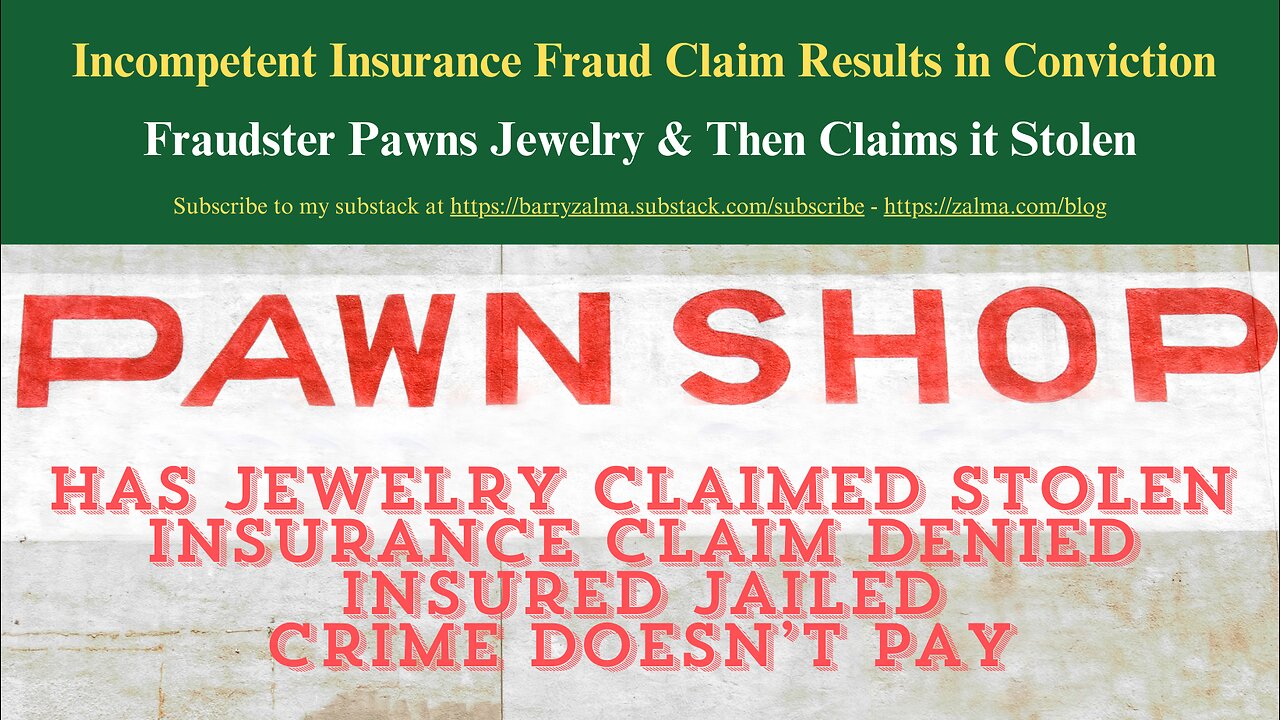Premium Only Content

Incompetent Insurance Fraud Claim Results in Conviction
Fraudster Pawns Jewelry & Then Claims it Stolen
Post 4796
The defendant, Vincent Chaney, appealed two orders from Superior Court denying his motions to suppress and for a new trial. In State of New Hampshire v. Vincent Chaney, No. 2022-0718, Supreme Court of New Hampshire (May 3, 2024) resolved the dispute over Chaney's conviction.
FACTS
In 2018, the defendant traveled to Florida and purchased three pieces of jewelry: (1) a necklace worth $63,138 (hereinafter, the large necklace); (2) a necklace worth $4,500 (hereinafter, the small necklace); and (3) a bracelet worth $16,050. Following the purchases, the defendant took out an insurance policy with Phoenix Insurance Company, also known as Travelers Insurance, on all three pieces of jewelry.
Chaney filed an insurance claim with Travelers Insurance for the small necklace and bracelet. Travelers Insurance paid the claim in March. In May, the defendant filed a second claim with Travelers Insurance alleging that the large necklace had been stolen during an armed robbery in Boston.
Travelers ultimately denied the second claim due to the defendant's non-cooperation and referred the case to the New Hampshire Insurance Department (Department), indicating that it believed the insurance claim to be suspicious. During the state's investigation, the investigator learned that Castro had twice pawned a bracelet identical to the one reported missing in the first insurance claim. At the time of the investigation, the bracelet remained at the pawn shop.
In December 2019, the investigator interviewed Ms. Castro who lived with Chaney after he obtained approval for a one-party intercept in order to record the interview. Castro described the three pieces of jewelry and alleged that they were all either missing or stolen. She stated that she had an older bracelet at her house similar to the one that went missing but that she had never insured the older bracelet due to its age. She also stated that she had never pawned the older bracelet.
Castro changed her story and stated that the bracelet at the pawn shop was the older bracelet that she previously claimed was at her house. The interview ended soon thereafter.
After obtaining a warrant the state's search discovered drugs, drug paraphernalia, multiple firearms, and one of the missing necklaces. The defendant was subsequently charged with possession of a controlled substance with intent to sell and numerous counts of being a felon in possession of a deadly weapon. The defendant was separately charged with three counts of insurance fraud in connection with the claims he made to Travelers Insurance.
ANALYSIS
To suppress evidence seized under a search warrant, the defendant must show that the misrepresentations in the supporting affidavit were material and were made intentionally or recklessly. Materiality is determined by whether, if the omitted statements were included, there would still be probable cause.
In its order on the defendant's motion to suppress, the trial court concluded that the affidavit supporting the search warrant did not contain any material misrepresentations or omissions that rendered the warrant invalid. Regarding the investigator's failure to mention the friend's corroboration, the court ruled any such omission was immaterial to a finding of probable cause.
Finally, the court found that, although the defendant's assertion that the investigator, rather than Castro, initiated the termination of the interview was "mostly accurate," The Supreme Court agreed with the trial court's well-reasoned and thorough order that the affidavit supporting the search warrant did not contain any material omissions or misrepresentations that rendered the warrant invalid.
The task of the issuing court is to make a practical, common-sense decision whether given all the circumstances set forth in the affidavit before it, including “veracity” and basis of knowledge of persons supplying hearsay information, there is a fair probability that contraband or evidence of a crime will be found in a particular place.
The reviewing court may consider only the information that the police brought to the issuing court's attention. Neither the issuing court nor the reviewing court could have considered the 2005 receipt when determining probable cause, and any alleged error in not attempting to introduce it at the suppression hearing did not prejudice the defendant's case. The order was affirmed and Mr. Chaney's conviction stood affirmed.
ZALMA OPINION
Mr. Chaney was involved in an amateurish attempt at insurance fraud by reporting the theft of jewelry that he had pawned, a fact easy for a police agency to establish but difficult for an insurer to determine. Chaney was caught when the pawned jewelry was found, a search warrant was obtained and the police not only found in his residence one of the "stolen" items, plus drugs sufficient to arrest him as a drug dealer as well as a perpetrator of insurance fraud. He tried to claim the warrants were improper and the Supreme Court refused his claims.
(c) 2024 Barry Zalma & ClaimSchool, Inc.
Please tell your friends and colleagues about this blog and the videos and let them subscribe to the blog and the videos.
Go to X @bzalma; Go to Newsbreak.com https://www.newsbreak.com/@c/1653419?s=01; Go to Barry Zalma videos at Rumble.com at https://rumble.com/c/c-262921; Go to Barry Zalma on YouTube- https://www.youtube.com/channel/UCysiZklEtxZsSF9DfC0Expg.
Subscribe to substack at https://barryzalma.substack.com/subscribe.
Go to the Insurance Claims Library – https://lnkd.in/gwEYk.
-
 2:12:33
2:12:33
Adam Carolla
2 days agoKamala Harris vs. Trump Wildfire Response + Jillian Michaels on Motherhood/Ayahuasca & Sperm Donors!
17.4K10 -
 LIVE
LIVE
Barry Cunningham
7 hours agoTRUMP DAILY BRIEFING: PRESIDENT TRUMP AND UK PRIME MINISTER STARMER HOLD PRESS CONFERENCE!
1,793 watching -
 1:44:47
1:44:47
The Quartering
4 hours agoEpstein Files RELEASED Today, Gene Hackman Mystery & Trump Vs Woke Reporters!
67.1K22 -
 1:19:38
1:19:38
Ben Shapiro
4 hours agoEp. 2147 - HUGE: The Washington Post SURRENDERS…To Reality!
76.6K15 -
 1:01:36
1:01:36
Russell Brand
17 hours agoThe Battle for Power: Trump’s Plan, Elon’s Purge & the DEI Illusion – SF545
181K55 -
 1:58:33
1:58:33
The Charlie Kirk Show
4 hours agoAmerica's Spiritual Revival + Runaway Judges + Vivek For Ohio | Habba, Waggoner, Vivek | 2.27.2025
128K17 -
 58:33
58:33
The Dan Bongino Show
7 hours agoAmerica's A-Team Hits The Ground Running (Ep. 2432) - 02/27/2025
839K1.25K -
 1:19:38
1:19:38
The Rubin Report
6 hours agoCNN Host Brutally Mocked for Trying to Profit Off of What He Called a ‘Conspiracy’
95.6K51 -
 2:00:42
2:00:42
Benny Johnson
22 hours ago🚨BREAKING: Epstein List, Flight Logs RELEASED Any Minute By Trump | ELITES IN PANIC
183K215 -
 2:10:17
2:10:17
Steven Crowder
7 hours agoEpstein File Watch & DOGE’s $17M Muppet Show Explained
577K413